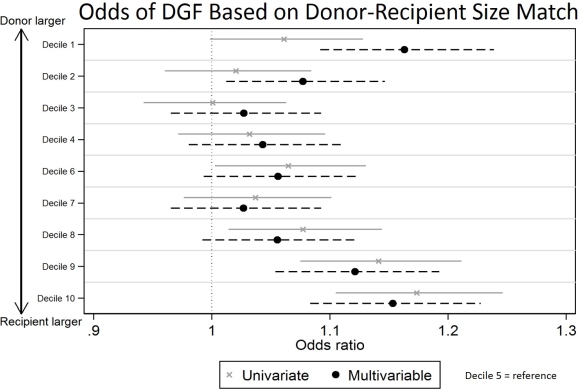Gender Differences in Kidney Transplant Delayed Graft Function Are Independent of Donor-Recpient Size Mismatch
1Surgery, University of Pennsylvania, Philadelphia, PA
2Surgery, University of Wisconsin, Madison, WI
3Medicine, University of Pennsylvania, Philadelphia, PA.
Meeting: 2015 American Transplant Congress
Abstract number: 474
Keywords: Graft function, Ischemia, Kidney transplantation, Prediction models
Session Information
Session Name: Concurrent Session: Kidney: Risk Prediction
Session Type: Concurrent Session
Date: Tuesday, May 5, 2015
Session Time: 4:00pm-5:30pm
 Presentation Time: 5:12pm-5:24pm
Presentation Time: 5:12pm-5:24pm
Location: Room 120-ABC
Introduction: Superior female tolerance of ischemia reperfusion injury (IRI) relative to males has been described in animal models, but little human data are available to confirm whether female gender is associated with lesser consequences of IRI in the transplantation setting. Delayed graft function (DGF) is the renal transplant functional result of IRI. We postulated that female gender would be protective against DGF and that donor:recipient size discrepancy would not account for gender-specific outcomes.
Methods: Deceased donor renal transplants (n=128,493) from UNOS data (1997-2011) were analyzed with the standard definition of DGF (dialysis within the first week after transplant) as the outcome using uni- and multivariable analysis.
Results: Male recipients had a DGF rate of 27.1% compared to 21.8% for female recipients. On multivariable analysis, male donor gender was modestly associated with increased DGF (OR 1.06 (1.01-1.11)) but male recipient gender was highly associated with DGF (OR 1.39(1.33-1.46)) independent of donor gender. We stratified donor and recipient body weight index by deciles to identify size discrepancy effects and noted that extremes of size mismatch were associated with increased DGF risk but that these effects were much smaller than the protective effect of female gender on DGF (Fig 1). By contrast, the magnitude of the gender recipient effect on DGF was not quite as great as ECD donor status (OR 1.59) or DCD donor status (OR 2.53), but was greater than recipient diabetes (OR 1.21) or panel reactive antibody > 80% (OR 1.38). Secondary analysis, eliminating pre-emptive transplants from the analysis, yielded equivalent findings.

Conclusion: Female recipient gender is a significant protective factor from DGF in renal transplantation and this effect is independent of size mismatch between donor and recipient. Extremes of donor:recipient size discrepancy do yield a smaller magnitude increased risk of DGF.
To cite this abstract in AMA style:
Levine M, Thomasson A, Aufhauser D, Redfield R, Abt P, Reese P. Gender Differences in Kidney Transplant Delayed Graft Function Are Independent of Donor-Recpient Size Mismatch [abstract]. Am J Transplant. 2015; 15 (suppl 3). https://atcmeetingabstracts.com/abstract/gender-differences-in-kidney-transplant-delayed-graft-function-are-independent-of-donor-recpient-size-mismatch/. Accessed December 17, 2025.« Back to 2015 American Transplant Congress
